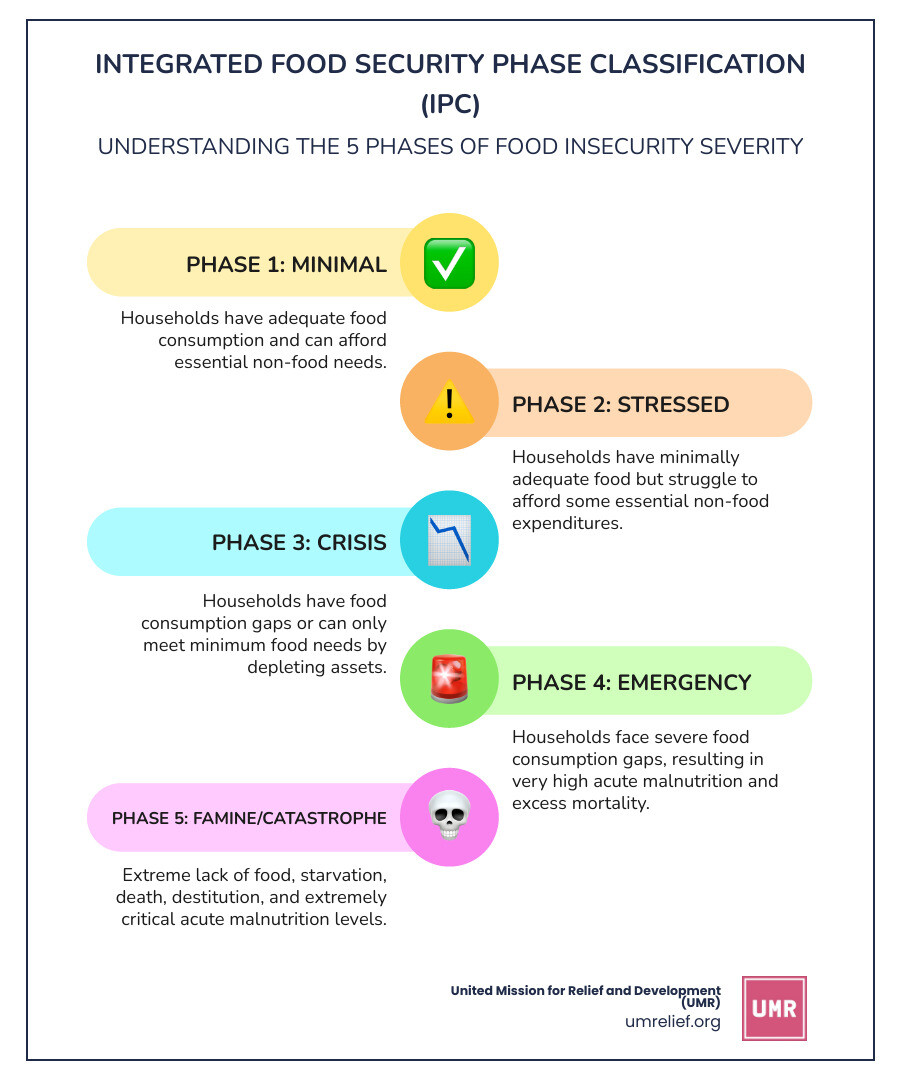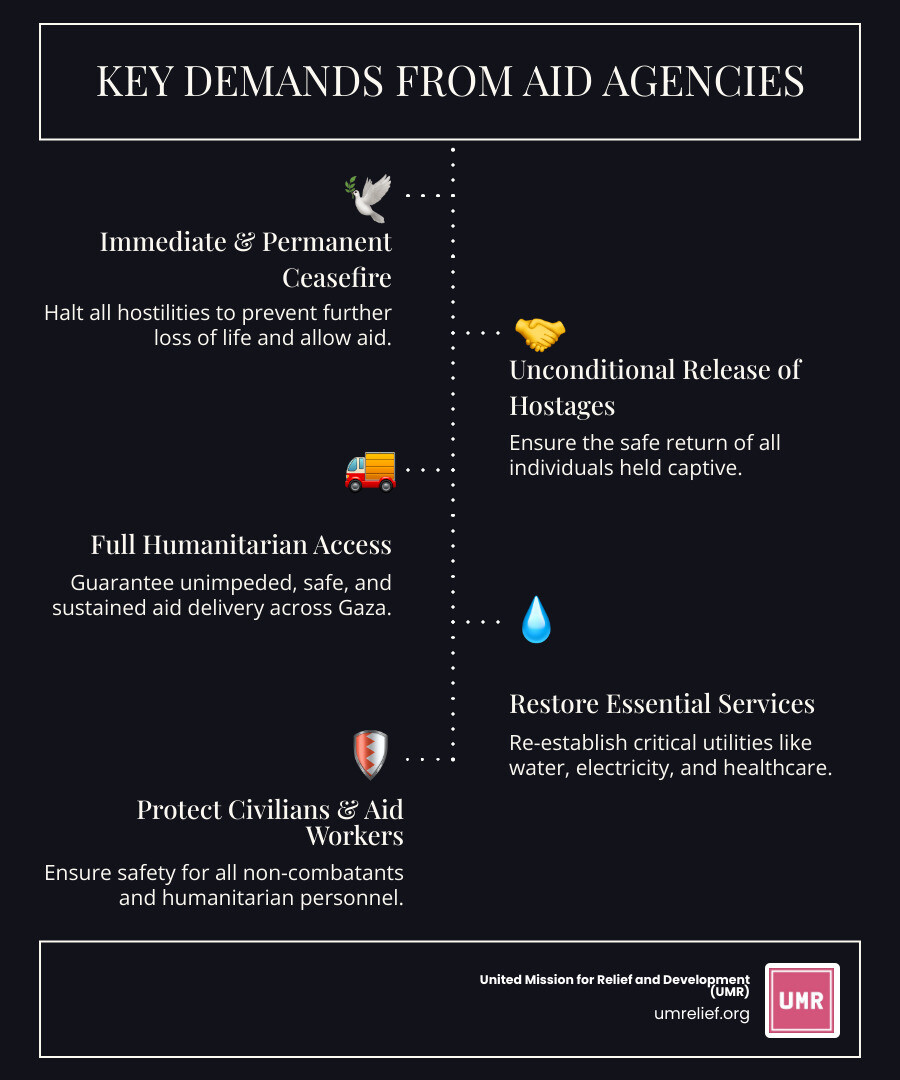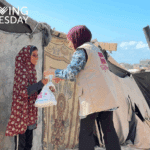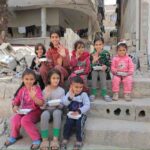Gaza food insecurity: Urgent 2025 Crisis
Why Gaza Food Insecurity Represents One of Today’s Most Urgent Humanitarian Crises
Gaza food insecurity has reached catastrophic levels. According to the latest Integrated Food Security Phase Classification (IPC) analysis, over half a million people face famine conditions, and the entire population of 2.23 million is experiencing severe hunger. This is one of the worst food crises of the 21st century.
Key Facts About Gaza Food Insecurity:
- Famine confirmed in Gaza Governorate with reasonable evidence
- Over 640,000 people expected to face Catastrophic conditions (IPC Phase 5) by September
- Two of three famine thresholds already reached: plummeting food consumption and acute malnutrition
- Over 320,000 children under 5 at risk of acute malnutrition
- 80% of starvation deaths are children
- 90% of the population has been displaced multiple times
The crisis stems from relentless conflict, mass displacement, and severe restrictions on humanitarian access. Essential services have collapsed, local food production has been devastated, and aid delivery faces constant obstacles.
What makes this situation particularly devastating is that it’s entirely preventable. This is a man-made catastrophe that requires immediate political action, sustained humanitarian access, and long-term support for Gaza’s resilient communities, who continue to show remarkable strength despite unimaginable hardship.
At our organization, we’ve witnessed how Gaza food insecurity devastates families fighting for survival.

The Scale of the Crisis: Understanding Gaza Food Insecurity
The situation in Gaza is not merely a food shortage; it is a full-blown catastrophe, with famine gripping entire communities. The Integrated Food Security Phase Classification (IPC) is the international standard for measuring the severity of food insecurity, and its latest analyses paint a grim picture. This multi-partner initiative provides a critical framework for understanding and responding to such crises.
According to the most recent IPC analysis, famine (IPC Phase 5) is confirmed in Gaza Governorate with reasonable evidence and is projected to expand to other areas. This isn’t just a warning; it’s a stark reality where widespread starvation and preventable deaths are already occurring. The IPC defines Famine by three criteria: at least 20% of households facing extreme food shortages, 30% of children suffering from acute malnutrition, and two deaths per 10,000 people daily from starvation. Tragically, these conditions have been met in parts of Gaza.
The sheer scale of this crisis is staggering: the entire population of the Gaza Strip, approximately 2.23 million people, is facing high levels of acute food insecurity. This means every single person is struggling to find enough food to eat, a situation almost unprecedented in modern history. The latest analysis underscores the urgency of the situation, calling for immediate and sustained action.
The Latest Data on Gaza Food Insecurity
The numbers are heartbreaking. By the end of September, more than 640,000 people are expected to face Catastrophic conditions (IPC Phase 5). This represents the most severe level of hunger, where families are experiencing extreme food deprivation and starvation. Beyond this, an additional 1.14 million people are classified in Emergency (IPC Phase 4), and 396,000 people are in Crisis (IPC Phase 3). This means nearly the entire population is caught in a spiral of acute hunger.
Alarmingly, two of the three critical famine thresholds have already been met: plummeting food consumption and acute malnutrition. More than one in three people are now going days at a time without eating. Research indicates that the proportion of households reporting very severe hunger doubled across the territory between May and July, and tripled in Gaza Governorate alone.
The Projected Outlook
If current trends continue, the outlook for Gaza food insecurity is grim. Famine conditions are projected to spread from Gaza Governorate to other areas. In the most likely scenario, assuming an escalation of the conflict, half of Gaza’s population a staggering 1.11 million people is expected to face catastrophic conditions (IPC Phase 5). This represents a 92% increase in people facing catastrophe compared to previous analyses.
The worsening hunger levels are reflected in alarming statistics. Projections show Global Acute Malnutrition (GAM) prevalence in Gaza Governorate could triple from levels seen in May, tragically surpassing the famine threshold. This escalation also brings increased displacement, with 90% of Gazas population having been displaced multiple times, further disrupting access to food. It’s a cruel cycle where conflict fuels hunger, and hunger exacerbates displacement.
Our UMR teams are working tirelessly to expand our emergency response efforts in Gaza, but the scale of the need is immense. You can learn more about our efforts and how we are trying to mitigate this crisis at More on UMR’s emergency response.
The Human Cost: Malnutrition’s Devastating Impact
Behind every statistic about Gaza food insecurity is a human story of unimaginable suffering. When we talk about malnutrition, we’re not just discussing numbers on a chart we’re talking about children whose tiny bodies are wasting away, mothers who can’t produce enough milk for their babies, and families watching their loved ones slowly fade.
The reality is heartbreaking. Over 320,000 children under five every single young child in Gaza now face the threat of acute malnutrition. What makes this even more tragic is that 80% of all starvation-related deaths are children. These aren’t just statistics; these are toddlers, babies, and preschoolers who should be growing strong.
Humanitarian health experts have sounded the alarm about the rapidly worsening situation, documenting a crisis that is spiraling out of control. Recent reports, including a WHO update (July 2025), indicate a rising number of children dying from hunger-related causes. Each of these deaths represents a family’s worst nightmare coming true.
Children and Vulnerable Populations at Extreme Risk
The numbers tell a story that’s hard to comprehend. In July, over 5,000 children received treatment for malnutrition, with many suffering from Severe Acute Malnutrition (SAM) the most dangerous form. Children with SAM are so thin their bodies are consuming themselves to survive, and their immune systems are too weak to fight off simple infections.
What’s particularly alarming is how rapidly things are deteriorating. More than 12,000 children were identified as acutely malnourished in July the highest monthly figure ever recorded and six times more than at the start of the year. Nearly one in four of these children were suffering from SAM, meaning they needed immediate medical intervention to survive.
But children aren’t the only ones at extreme risk. Over 40% of pregnant and breastfeeding women are now severely malnourished. This creates a devastating cycle malnourished mothers can’t produce enough breast milk, and their babies are born already fighting for their lives. The result? One in five babies are now born premature or underweight.
The connection between malnutrition and disease makes everything worse. When children’s bodies are weakened by hunger, common illnesses become killers. Diarrhea affected 43% of children in July, and with contaminated water everywhere, infectious diseases spread rapidly.
The Long-Term Consequences of Malnutrition
Even if this crisis ended tomorrow, the damage would last for generations. Stunted growth isn’t something children can recover from easily. When young brains don’t get the nutrition they need during critical development periods, it affects their ability to learn and reach their full potential for the rest of their lives.
Impaired cognitive development means that children who survive this crisis may struggle in school and face challenges that will follow them into adulthood. Their weakened immune systems will make them more vulnerable to illness throughout their lives.
This creates a generational health impact that’s almost impossible to reverse. We’re looking at an entire generation of children whose futures have been stolen by preventable hunger. Projections show that tens of thousands of children under five are expected to suffer from acute malnutrition in the coming years.
At UMR, we understand that addressing Gaza food insecurity requires more than just emergency food aid. That’s why our comprehensive approach through food security and livelihood support focuses on building sustainable solutions that help communities not just survive, but eventually thrive again. Because every child deserves the chance to grow up healthy and full of hope.
Drivers of the Crisis and Barriers to Aid
The Gaza food insecurity crisis didn’t happen overnight. It’s the tragic result of ongoing conflict that has torn apart the very foundations of daily life. It’s hard to imagine the constant fear and uncertainty that comes with never knowing if your home will be there tomorrow.
Ninety percent of Gaza’s population has been displaced, and many families have had to flee their homes multiple times. This constant movement makes it nearly impossible for families to find steady food sources or maintain any sense of normalcy.
The destruction has been overwhelming. Seventy percent of Gaza’s infrastructure lies in ruins. Homes, hospitals, roads, and water systems have been severely damaged or destroyed. Without these essential services, even the simplest tasks like cooking a meal or storing food become major challenges.
How Conflict Drives Gaza Food Insecurity
The connection between conflict and hunger in Gaza is heartbreakingly clear. When war destroys the places where food is grown, stored, and sold, entire communities lose their ability to feed themselves. About 98% of Gaza’s cropland is now either damaged or completely unreachable, which means local farmers can’t grow the fruits and vegetables families depend on.
Fishing, a way of life for many Gaza families, is now banned. This cuts off not just a source of food, but also the livelihoods of thousands. The economic impact is staggering. Wheat flour prices have increased by 3,400% since late February in Gaza Governorate. Even when food exists, most families simply can’t afford it.
The collapse of local markets means that the normal flow of goods has stopped. Without functioning roads and with destroyed warehouses, the entire food system has broken down. This connects directly to other crises too – our work addressing the interconnected water crisis in Gaza shows how essential clean water is not just for drinking, but for cooking and any hope of growing food again.
Key Challenges in Delivering Humanitarian Aid
Getting help to Gaza’s families faces enormous obstacles. Even when trucks loaded with food are ready to go, severely restricted access means they often can’t reach the people who need them most. It’s incredibly frustrating for everyone involved.
Gaza needs more than 62,000 metric tons of food every month just to meet basic needs. In the first half of August, only 55,600 metric tons made it in – not enough for one month, let alone to make up for previous shortages.
Aid convoy obstructions happen regularly, with reports showing that a vast majority of humanitarian aid trucks have been intercepted. This creates a cruel situation where food meant for hungry children never reaches them. Major aid agencies have the ability to deliver tens of thousands of metric tons monthly, but they need safe, reliable access.
The dangers faced by aid workers and civilians seeking help are unimaginable. Hundreds of humanitarian aid workers have lost their lives. Even more tragic, more than 1,000 people have been killed and over 7,000 injured simply while trying to get food since late May. The basic act of looking for something to eat has become life-threatening.
What makes this even more challenging is what aid officials call a “militarized distribution system” that can’t keep up with the massive need. Safety risks for everyone involved make every delivery a dangerous mission.
The Global Response and Calls for Action
The world is watching Gaza, and the response from international humanitarian organizations has been both urgent and unified. Humanitarian organizations and governments across the globe are sounding the alarm about Gaza food insecurity, calling it a preventable, man-made catastrophe that demands immediate action.
These are organizations with teams on the ground, witnessing the devastation firsthand. Relief organizations are working tirelessly in impossible conditions, and their message is crystal clear: this crisis can be stopped, but only with decisive political action and unimpeded humanitarian access.
The frustration in their statements is palpable. When senior international officials say “The facts are in, and they are undeniable,” you can hear the urgency of someone who knows that every day of inaction means more preventable deaths. These aren’t just diplomatic statements – they’re desperate pleas.

Calls to Action from UN Agencies and Aid Organizations
The humanitarian community’s demands are straightforward because the situation is that urgent. There’s no time for diplomatic niceties when children are dying of starvation.
The most critical demand is an immediate and permanent ceasefire. Without this, everything else becomes nearly impossible. A ceasefire isn’t just about stopping the violence – it’s about creating the basic conditions needed for survival.
Equally important is the unconditional release of hostages. This humanitarian issue is recognized as essential for de-escalation and creating an environment where aid can flow freely.
The call for full and safe humanitarian access cannot be overstated. A vast majority of aid trucks are being intercepted. That’s not just a logistics problem – it’s a death sentence for families waiting for food. The humanitarian community needs predictable, safe corridors to deliver life-saving supplies.
Restoration of essential services goes beyond just food. Clean water, healthcare, sanitation, and energy are all interconnected with nutrition. You can’t address Gaza food insecurity without addressing the collapse of these basic systems.
Perhaps most fundamentally, there’s the demand for protection of civilians. The fact that over 1,000 people have been killed while simply trying to access food shows how basic humanitarian principles have broken down. International humanitarian law must be respected.
The Role of International Aid and Political Decisions
Humanitarian organizations can only do so much without political will. Operations in Gaza and the West Bank require hundreds of millions of dollars in funding to continue.
But money alone won’t solve this crisis. Gaza food insecurity is fundamentally a political problem that requires political solutions. International officials have been remarkably direct, stating that countries with leverage who fail to pressure for change may be complicit in international crimes.
The international community needs to push for more than just emergency aid. We also need to restore commercial food flows, rebuild market systems, and support local food production. Gaza had a functioning economy before this crisis – with the right support, it can again.
At UMR, we’ve witnessed incredible generosity from donors who understand that this isn’t just about Gaza – it’s about our shared humanity. Every contribution matters, whether it’s direct support or advocacy for policy changes.
The path forward requires both immediate humanitarian action and long-term political commitment. If you’re wondering how you can be part of the solution, I encourage you to explore How you can help Palestine. Because ultimately, ending Gaza food insecurity is something we all have a role in addressing.
Frequently Asked Questions about Food Insecurity in Gaza
When people learn about the devastating Gaza food insecurity crisis, they naturally want to understand what these overwhelming statistics really mean for real families. As someone who works daily with humanitarian data and donor concerns, I hear these questions frequently. Let me share what we know from our work on the ground and the latest research.
What does it mean that famine is “confirmed” in parts of Gaza?
When famine is confirmed, it means three specific thresholds set by the Integrated Food Security Phase Classification (IPC) have been met: 1) At least 20% of households face extreme food shortages. 2) Over 30% of children suffer from acute malnutrition. 3) At least two people per 10,000 die daily from starvation. Evidence confirms these devastating conditions have been met in areas like Gaza Governorate, making it a confirmed humanitarian catastrophe happening right now.
What are the specific nutritional needs of mothers and infants?
Pregnant and breastfeeding women need significantly more calories, protein, and vitamins, which are now unavailable. This leads to tragic outcomes, with one in five babies now born prematurely or underweight. Malnourished mothers struggle to produce enough milk, and infants need safe access to breastmilk substitutes and clean water, both of which are critically lacking. Over 40% of pregnant and breastfeeding women are now severely malnourished, putting two generations at risk.
What are the long-term consequences of this food crisis?
The effects will be generational. Children who survive malnutrition face irreversible consequences like stunted growth and impaired cognitive development. The economic devastation from destroyed cropland and collapsed markets will persist for decades, creating cycles of poverty. Furthermore, the psychological trauma of starvation and displacement will have a lasting impact on the population’s ability to rebuild their lives and communities. This crisis will create profound scars that make recovery a monumental challenge requiring sustained, comprehensive support.
Conclusion
The Gaza food insecurity crisis is a heartbreaking, preventable disaster. Relentless conflict has destroyed the foundation of life for 2.23 million people, creating a man-made famine that could have been avoided.
The numbers tell a devastating story. Famine is confirmed in Gaza Governorate, with over 640,000 people facing catastrophic hunger. But behind every statistic is a family struggling to survive. The systematic destruction of infrastructure, the collapse of local food systems, and severe restrictions on humanitarian aid have created a perfect storm of suffering.
Children are paying the highest price. Over 320,000 little ones under five face acute malnutrition, and tragically, 80% of starvation deaths are children. These aren’t just numbers – they represent an entire generation whose futures hang in the balance. The long-term consequences will echo for decades.
Yet through all this darkness, the resilience of the Palestinian people continues to shine. Families share what little they have, and communities support each other despite having almost nothing. This strength in the face of unimaginable hardship reminds us why our work matters so much.
At UMR, we are working to deliver life-saving aid including food, clean water, and healthcare. Every dollar donated reaches those who need it most through our transparent, sustainable approach to humanitarian work.
The international community has made its demands clear: immediate ceasefire, unimpeded humanitarian access, and restoration of essential services. These are the minimum requirements to prevent further loss of life.
Time is running out. But it’s not too late. With sustained international pressure and the political will to prioritize human life, we can still make a difference. The people of Gaza haven’t given up, and neither should we.










